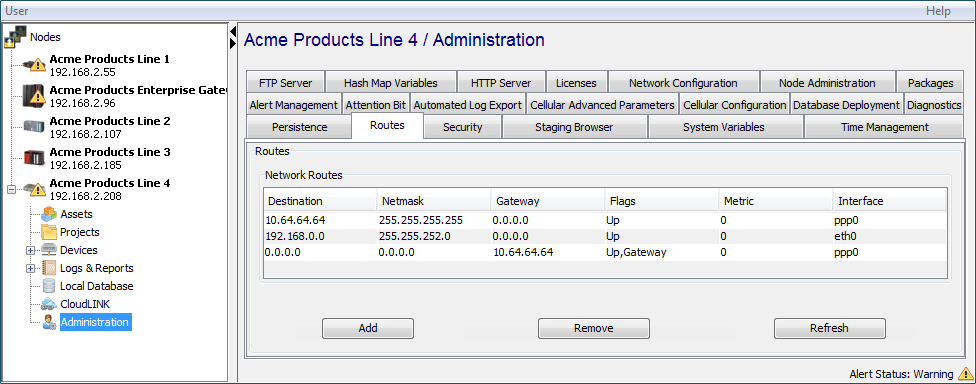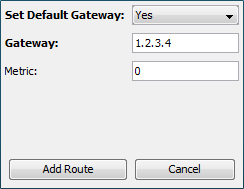The Routes tab is used to view and
manage entries in the system's routes table.
This tab is not available for all products. For products that do not display a Routes tab, the underlying operating system tools must be used to manage the routes table.
Managing routes table entries
The network management and cellular modem components will add gateway entries to the system's routes table as part of their initialization processing as follows:
- When the network management component initializes, it will add a gateway entry to the routes table if the Default Gateway parameter is set for a network adapter. The Interface column will identify the network adapter (eth0, eth1, etc.).
- When the cellular modem component connects to the cellular service provider, it will check the routes table for a network gateway entry. If there is no network gateway in the routes table, the cellular modem component will add a gateway entry. The Interface column will identify the cellular modem connection as ppp0 (Point-to-Point Protocol).
The columns in the table are as follows:
| Column | Description |
|---|---|
| Destination | The destination IP address subnet portion of a target IP address. |
| Netmask | The destination IP address subnet mask, used in combination with the Destination parameter to determine the target subnet. |
| Gateway | The network gateway to use when going to a target IP address. |
| Flags | An indication that the route is available (Up) and whether the entry is for a network gateway (Gateway). |
| Metric | When there are multiple network gateways, the one with the lowest number metric is chosen first. |
| Interface | The Ethernet adapter (eth0, eth1, etc.) or cellular modem driver (ppp0) to use to reach the target IP address. |
Adding a route entry
If an entry needs to be manually added to the routes
table, select the Add button.
An Add Route window is displayed:
The parameters are as follows:
| Parameter | Description |
|---|---|
| Set Default Gateway | The options are:
|
| Destination Network | Available when Set Default Gateway is No. The destination IP address subnet portion of a target IP address. |
| Destination Netmask | Available when Set Default Gateway is No. The destination IP address subnet mask, used in combination with the Destination Network parameter to determine the target subnet. |
| Gateway | The IP address of the network gateway. |
| Metric | A value from 0 to 1000 used to indicate which of multiple gateways should be used first. The lower number metric entries are used before the higher number metric entries. |
After entering the parameters, select the Add Route button to add the routes table entry.
An entry can be removed from the routes table by selecting the entry and selecting the Remove button.
After making changes, select Save to save the changes.
The Routes tab image at the top of this section shows an Asset Gateway with routes table entries configured for access to devices on the LAN over the Ethernet adapter (eth0) and access to the deviceWISE Cloud (typically api.devicewise.com) over the cellular modem connection (ppp0).
The following Routes tab image shows the the same routes table when the Network Configuration tab has a Default Gateway configured for Ethernet Adapter 1 (eth0). In this case, the network gateway at 192.168.1.1 needs to be able to route traffic destined for the deviceWISE Cloud.
